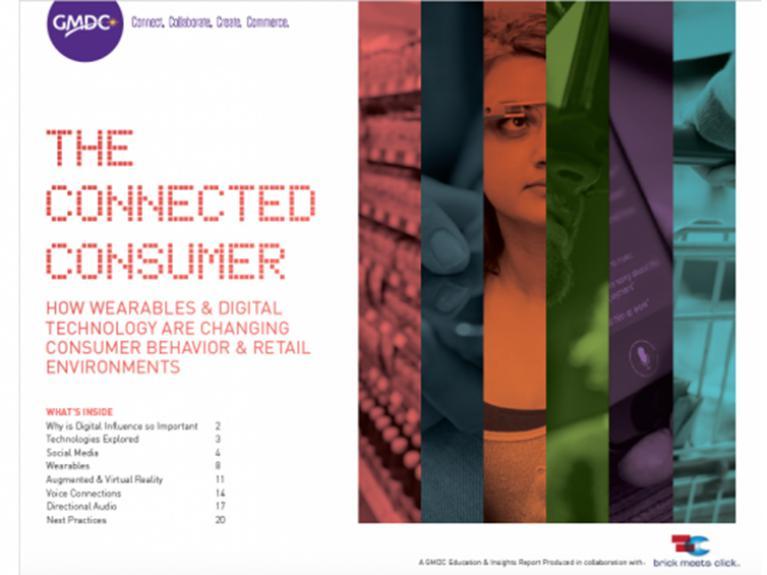GMDC: From wearables to VR, digital is shaping tomorrow's shopping experience
COLORADO SPRINGS, Colo. – Today’s connected consumer is plugged-in to a variety of technologies to keep them moving forward in an increasingly digital world – and wearable technologies are fueling that trend – according to new research released by the Global Market Development Center on Tuesday.
“Our industry is rapidly transforming through new technologies, apps, digital and online capabilities, and the connected consumer is driving the market,” stated Patrick Spear, president and CEO of GMDC. “In fact, our research reported nearly half of all in-store retail sales were influenced by digital in 2014, and by the end of 2015, 64% of in-store sales were expected to be affected. As we continue to spotlight tomorrow’s trends and point toward the store of the future, this report answers the ‘now what’ question for member trading partners.”
GMDC’s latest “next practices” report called “How Wearables and Digital Technology Are Changing Consumer Behavior & Retail Environments,” produced in collaboration with Brick Meets Click, explores the evolving technologies reshaping consumer behavior in the marketplace: social media, wearables, augmented reality, virtual reality, advanced voice and directional audio.
Wearables
Wearable technologies – such as Fitbit and Apple Watch – which literally keep the pulse of today’s connected consumer by monitoring physical activities with a variety of data and diagnostics at the tip of your hand – are expected to vault more than 200% from 80 million units sold in 2015 to 214 million in 2019. Sales are expected to nearly triple from $2 billion in 2015 to $5.8 billion by 2019.
Wearables, a big and diverse category, can be grouped by where they are worn/located or by their focus. Wrist-worn devices dominate today. Wearables users consider themselves early adopters. They are split evenly between men and women and skew younger – 48% are 18 to 34 and 52% are 35 and older.
New Realities: Augmented and Virtual
Closely following wearables in popularity are augmented reality and virtual reality. Huge investments in AR and VR can be seen in Q1 of 2016 – over a billion dollars. Corporate giants, like Google, are working on development while other companies, like Netflix, have launched virtual reality stores. AR is expected to be more popular than VR since connected consumers can access it at a lower cost with no special equipment needed.
Social Media
Today’s social media is all about sharing pictures, news and experiences with friends, family and colleagues – and even strangers who share common interests via a group or mutual connections. For many connected consumers, social media is replacing mass media as their main source of information. Each social platform has its own personality and plays a different role in the lives of users. Most importantly, images and user-generated content have become the new language of social media. Snapchat is a good example of both in action. Content is visual, almost always user-generate, and tends to be spontaneous and unpolished.
Advanced Voice
Most connected consumers with smartphones are familiar with voice input capabilities. The more people try it, the more times and places they find that voice is they best way to interact with their device. Amazon’s Echo device and its voice-controlled digital assistant, Ask Alexa, act as both a listener and speaker. Voice connections are powerful because input is easy and often hands free, and help is delivered “in the moment.”\
Directional Audio
Connected consumers love the comfortable, almost private listening experience, directional audio delivers, whether at home, in the car or at the store. The ability to deliver audio directly to the individual makes it feel like wearing earphones without the gear. A study on the impact of directional audio installed in a grocery dairy department found there was an 87% increase in the number of shoppers who purchased a new organic dairy product they had not known about previously.
“Digital connections are exploding, which means there are more communications channels to reach connected consumers, but that could also mean increased fragmentation and potentially less efficient communications,” said Bill Bishop, the white paper’s lead author and chief architect of Brick Meets Click. “Retailers and suppliers are learning to talk digital. In the coming years, digital influence will play an increasingly important role in marketing and merchandising, so the two groups must not only execute the current standards but also consider how they can develop future standards.”
Energizer and Big Time Products sponsored GMDC’s Connected Consumer “next practices,” with Nielsen contributing to the consumer insights.


